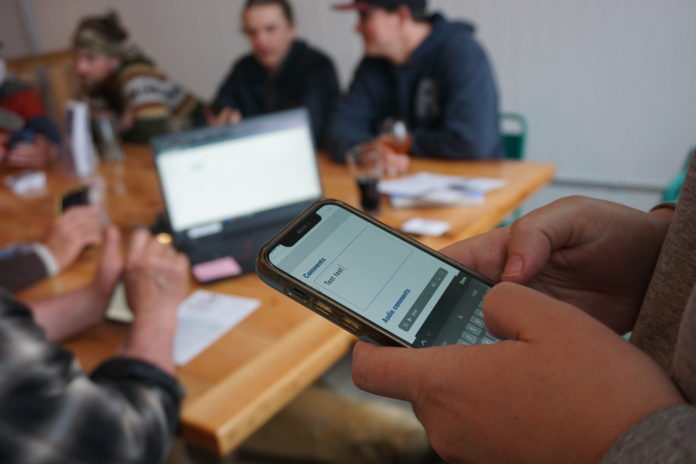
The Skipper Science Partnership visited Cordova this past week to share new updates to their mobile app with fishermen. The partnership is an expansion of the Indigenous Sentinels Network (ISN) online database, which has been fostering citizen science in parts of rural Alaska for over 20 years. The mobile app focuses on collecting and organizing observations from fishermen and ocean users in the hopes of better communicating their experiences in conversations with resource managers, scientists, and legislators.
Skipper Science has been to Cordova on several occasions, beginning in 2021 when the app first launched. Officials from the program focused on sharing recent software updates with current users, as well as training new users ahead of the upcoming salmon season during this week’s visit. Representatives set up a booth at Cordova District Fishermen United’s annual member meeting and hosted two separate “mug-ups” at Copper River Brewing. Fishermen were able to learn about the partnership’s pilot projects and test the app with the help of Skipper Science staff.
McKenzie Smith, a local Copper River salmon fisherman, was present at both events and was one of the first dedicated users of the app in the region.
“(Skipper Science) found me through social media and reached out to me,” he said of his first season working with the app. “My first summer I probably did about 15 observations.”
The partnership currently has financial incentives for fishermen to participate with the opportunity to win $500 for their in-season observations. But Smith says the value of logging in the app was more than financial.
“I think it’s important that people are open minded about sharing their own personal observations to the science community,” he said. “It’s important that we advocate for a better fishery.”
Observations currently collected by the mobile app include weather and water conditions, temperatures, and fish and seabird observations. Recent updates to the app included a more streamlined mobile screen and additional observation sections. Other aesthetic updates such as a branded color scheme were also added to benefit the user experience. Each recorded observation now also has the ability to include latitude and longitude, allowing for a spatial dimension to be added to the database.
These observations by ocean users are intended to act as data points that center local community voices in natural resource management. Data logged by fishermen within the app is organized and quantified annually in a report available to state and federal fisheries managers. This effort addresses community concerns about natural resource use while also giving additional data to scientists.
Hannah Marie Garcia, the ISN coordinator, explained the role that the Skipper Science Partnership hopes to fill.
“We’re the bridge between fishermen and scientists,” she said.
While the partnership is currently working most closely with federal managers at NOAA, Garcia says that they are exploring new possible collaborations with state managers as well.
“We’re constantly pushing on all doors whether it’s the state or federal, but also academic research partners too,” she said.
The Skipper Science Partnership hopes to address several challenges of scale and outreach in the coming year. Visiting coastal communities who use the app is a part of the partnership’s goal of continuing to grow its user base. According to Garcia, the Copper River region has been one of the most active communities in the program thus far.
“It’s been a testament to Cordova as a community,” she said. “This is a really engaged fleet that are active and passionate about being stewards and local knowledge experts of what they are seeing.”





